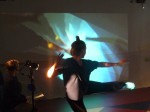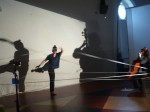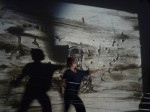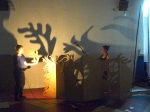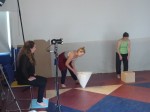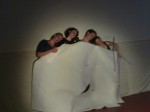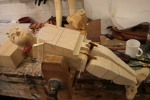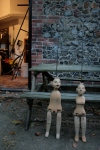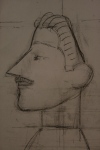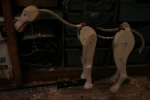In the weeks building up to the end of our Kickstarter campaign for Beauty and the Beast (http://kck.st/WL7sBo), there will be a series of posts introducing you to members of our wonderful creative team. This week, we’re talking to Mark Mander, an experienced puppetry performer who is taking on the costumes for Beauty and the Beast.
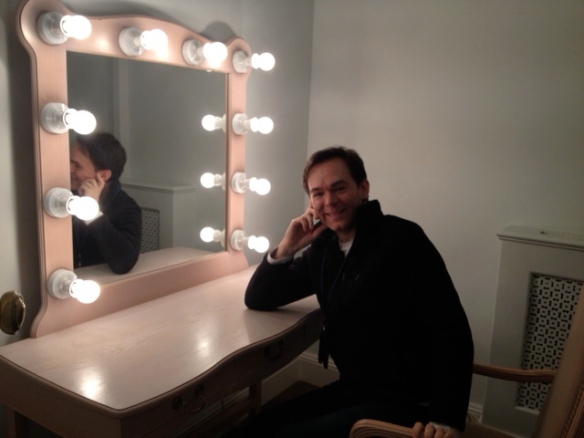
Mark Mander answered his call to puppetry at the age of six when being inspired by watching the Muppet show – since then, he has worked with puppetry in London and Norwich, including taking up the mantle of performing as George from the legendary TV show Rainbow, as well as performing in various children’s TV shows with the BBC and ITV. For Beauty and the Beast, he’s creating some of the costumes and scenery; we caught up with him to ask him about what makes a good puppetry performance, as well as what lies ahead in the show…
Q1) What attracted you to the Beauty and the Beast project?
I have been involved with the Beauty and the Beast project since it began. A couple of years ago I approached the artistic director Joy Haynes about putting on a traditional marionette show. We looked at a couple of stories but both loved Beauty and the Beast. Joy then created a brilliant team to workshop the story, then a second team and cast to bring the story to life. The production is now much more elaborate than a simple marionette show, with specially commissioned music and lots of dynamic ways to present the puppets.
Q2) What makes a good puppet aesthetically?
Thats a little like ‘How long is a piece of string’!
I was flicking through an old book on puppetry recently and the puppets featured dated mainly from the 50’s and 60’s. It was refreshing to see how many different forms the puppet can take. For instance, the human figure can be represented in a highly ‘realistic’ way with naturalistic proportions and detailed miniature costumes and at the other end of the scale it can be entirely abstract- maybe a few pieces of wire and a scrap of cloth. Its easy to think that ‘deconstructed’ puppets, like the amazing horses created by the Hand Spring company for War Horse are a new idea. In fact they are as old as puppetry.
But to try and answer your question – aesthetic tastes come and go out of fashion, from highly elaborate Victorian Marionettes which look like miniature actors to the 3d ‘sketches’ of horses in War Horse which evoke the movements of a real horse , but whose aesthetics rely on revealing the beauty of their complex machine like construction.
I think the most successful puppets from an aesthetic point of view are ones which an audience finds accessible and engaging. The puppet is there to do a job- that of portraying a character (or an abstract emotion). Puppets are really kinetic objects and how the puppet moves is as important as what the puppet looks like. Cute and fuzzy puppets are loved on TV and starker, more abstract puppets are currently in fashion on the stage. Both are equally ‘valid’ from an aesthetic point of view if they engage the audience and help tell the story and go to prove how adaptable puppet aesthetics can be.
Q3) What can we expect from the show in terms of the puppets and costume?
Ask a showman to give away details and he will tell you ‘Come and SEE the SHOW!’ The puppets MIGHT be based on Sicilian puppets. These are marionettes which have a metal rod to the head. This allows the puppet to have very sharp, definite, quick movements. A marionette with strings to the head has softer more ‘floaty’ movements. The costumes are still very much a work in progress- but they will have the flavor of old Hollywood , when the roaring twenties gave way to the glamour of the silver screen in the nineteen thirties .
Q4) It’s the 35th anniversary of the Norwich Puppet Theatre when the show begins. Does the performance utilise the space in any historic way?
I have a long and happy association with the Norwich Puppet Theatre. I have performed my character “Clementine the Living Fashion Doll” many times here and it was during the special 30th anniversary show at the theatre, when Clementine was singing a finale song, floating on a moon 15 feet above the audience, that it struck me just what a brilliant resource the NPT Marionette Bridge is. (The performance can be seen HERE; http://vimeo.com/30625938)
(A Marionette Bridge is a raised platform with a leaning bar running along it at waist height. Marionettes or String Puppets can be operated from above the stage floor using the bridge, often on strings of 2m or more)
Not wanting to destroy any illusions, but to operate ‘Clementine’ i was actually sitting on the very edge of the Marionette Bridge , with the artistic director holding on to my belt, preventing me plummeting to my doom!!! (Luckily we are on good terms and she continued to pull, not push).
The marionette bridge is a unique piece of stage machinery- the only one of its kind in the uk. It was purpose built by the brilliant Ray Dasilva when he created the theatre.
Of course the Little Angel Theatre in London also has a wonderful purpose built bridge- as does the Puppet Barge on the Thames, but both of those are static. Norwich Puppet Theater’s version is made of steel and can be raised and lowered AND move towards or away from the audience AND can be split in half.
When I was sitting on the edge of the Marionette bridge it was the first time this amazing piece of stage machinery had been used for several years.
The new production of Beauty and the Beast will see the unique and wonderful resource of the Marionette Bridge used to full effect- a great way to mark the 35th anniversary of the company.
Q5) What are the challenges in creating for a show like this?
One of the greatest challenges in creating a show based on a ‘classic’ story which people know and love (Especially when it is a well known film) is to forget about what other versions of the story have gone before- and to find a new way to tell the tale.
I think the NPT version will have enough elements of the familiar story to please those who like ‘tradition’ but it also contains new themes and a fresh new approach to make it appeal to everyone.
Q6) What sparks your passion for creating puppets & performing with puppets?
What sparks my passion for Puppets? I’m one of those lucky people who always had a very clear vision of what i wanted to do , even as a child- and that vision was to be a puppeteer. The Muppet Show was on TV and it was a huge hit in the UK- so it proved to me that it was possible to be a professional puppeteer and i was lucky enough to have the Norwich Puppet Theatre on my doorstep. Today one can take courses in puppetry, but back then it was a simple case of DIY! I wanted to be a puppeteer so i started building puppets, writing scripts and subjecting my poor family to hour long puppet shows from behind an ironing board.
My family were always very supportive of this odd career choice and i eventually started working at the NPT, then its ‘Cousin’ in London, the Little Angel Theatre, then broke into TV puppetry.
What keeps my passion for puppetry going? I think puppetry is a very magical phenomenon- making bits of wood, felt or plastic appear to be alive is a strange thing to do on the face of it. When those various bits of inanimate matter are moved with skill and thought, an audience can be amused by them- or genuinely feel that the puppet is experiencing emotions.
Humans seem to be hard wired to want to hear stories. Puppets are great story tellers, and even though they are entirely artificial they are very ‘honest ‘ in a way. Take the Beauty puppet from this production. She may be a new take on an traditional fairytale heroine, but you will never see her in an episode of Eastenders or in Hello Magazine getting married to a footballer – in the same way you might if she was being played by an actress. Beauty will be 100% the heroine of our show and she will go through a range of emotions which the audience can relate to when she meets the terrifying beast. Yet Beauty will really probably be some bits of wood and fabric. Thats why i continue to love puppets- because they are great storytellers and they are magic.
Q7) Why should people back the Kickstarter fund?
The Norwich Puppet Theatre is a real gem of a place, not just for Norwich but for the entire UK . It continues to be both a receiving house for the best puppetry work from all over the world, and also produces new work of international quality by leading practitioners in the field of puppetry. No one needs reminding of the financial situation currently facing the county as a whole and the Arts in particular- but by donating to the Kickstarter fund people will be supporting the creation of a fantastic new puppet production.




























